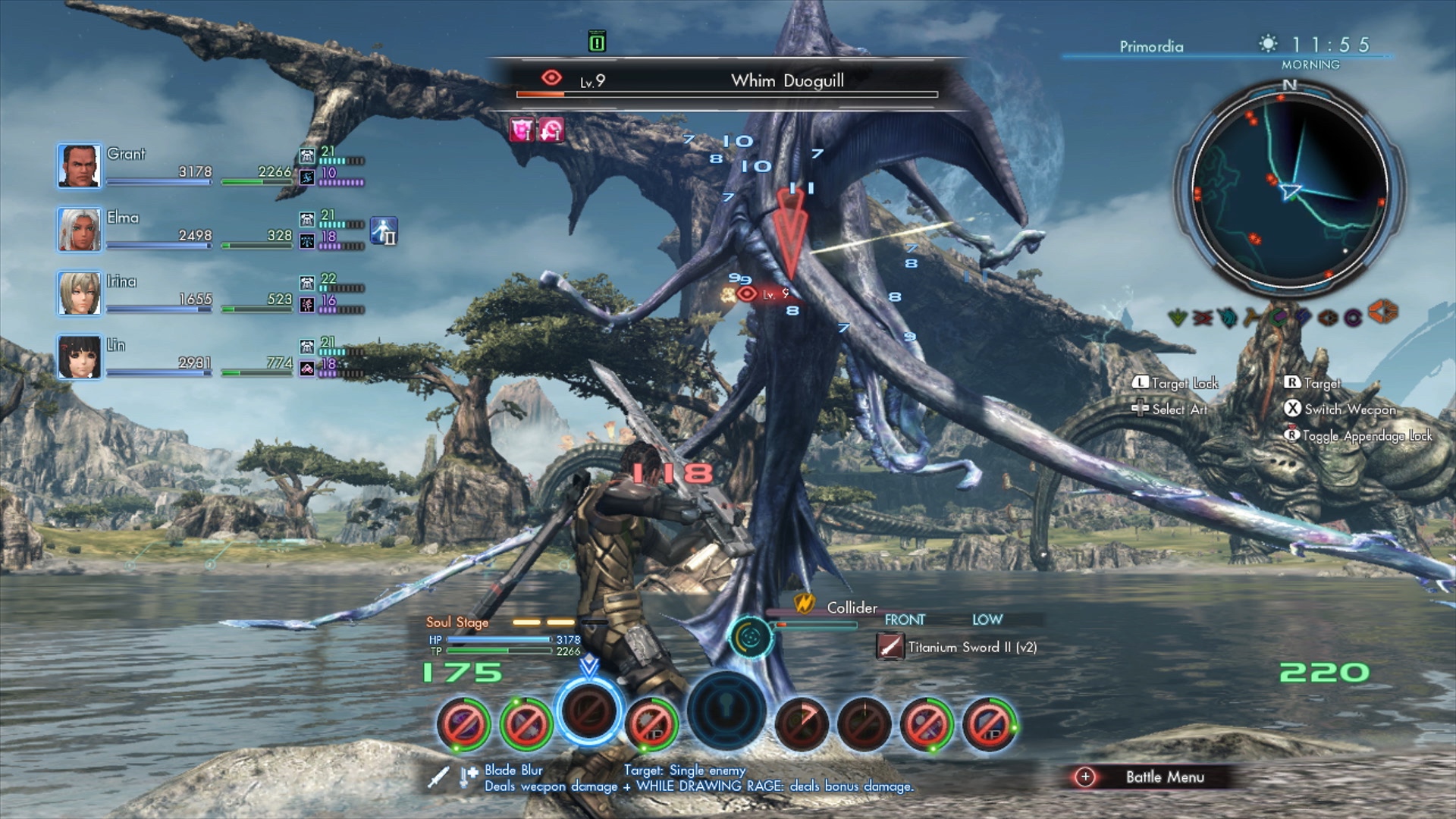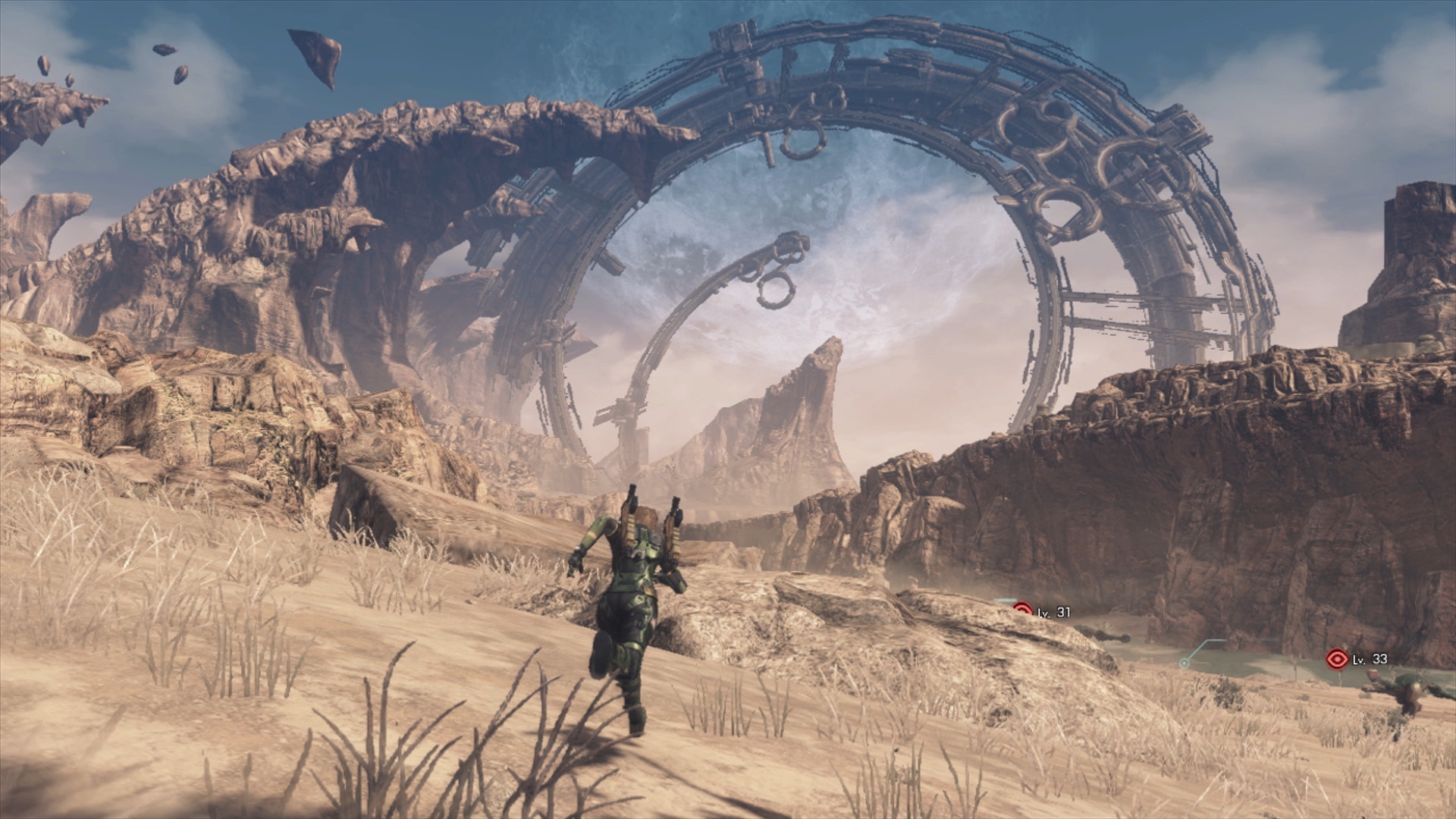The good: Huge and beautifully realized world to explore, excellent gameplay systems work well together
The bad: Insufficient documentation—and this is a game that could use a better manual
Bottom line: Hands-down the best roleplaying game of 2015
Forty-six hours of your life feels like plenty to surrender to any video game. And yet if I’m reading Xenoblade Chronicles X‘s numbers right, I’ve chewed through less than half its alien other-lands, its sweeping herds of indigenous fauna (dubbed “indigens,” some so enormous they blot out the sky at a hundred paces), its labyrinthine gameplay systems and its dazzling panoramas with arcing geological formations that soar above you.
That you can wander anywhere your eyeballs register is only the game’s surface allure, an assimilation of the Western roleplaying genre’s penchant for turning players loose in freaking ginormous spaces where who-knows-what lurks around any corner. In other games, most of those places turn out to be facile—battle zoos under a patina of storytelling. Scrape it off, and you’re either fighting or looking for more stuff to fight.
Xenoblade Chronicles X makes no such pretense. It knows what it is, and doubles down by inviting players to knock about its sprawling menageries without worrying whether the story makes sense or caring much about its characters. The twists and wrinkles lie instead in the gameplay (where they should be). A library of interesting ideas slowly unwinds, eventually ramifying in ways that challenge not just a gamer’s ability to cleave through the next lot of refrigerator-poetry-christened “grotto mortifoles” or “echo gemivores” or “viridian monoceros,” but his or her basic grasp of how the game works at all.

It’s further evidence of a design restlessness that’s marked most of Japan-based director Tetsuya Takahasi’s work, best realized in 2012’s superb Xenoblade Chronicles for the Nintendo Wii. Xenoblade Chronicles X isn’t a direct sequel to that game, but echoes its core ideas: realtime battles where you trigger abilities (“arts”) and shoot for combat bonuses by complementing whatever your teammates are up to, and collection-driven exploration. The difference is that instead of working your way quasi-linearly through a world that unlocks in segments, you can go anywhere on planet Mira from the start. Well, sort of. Indigens are ubiquitous, and the most lethal often roam in eyeshot of the most benign. I noticed one player on a forum devoted to the game complaining that the planet’s hostiles were making free exploration difficult, to which another quipped: “It’s as if you’re stuck on a hostile alien planet or something!”
Never mind how insanely big and dangerous Mira is, you’re busy enough just getting your hands around the periodic gameplay changeups. Xenoblade Chronicles would trot out a new idea, then lay in another, then more still, until it felt like you were playing outwards from the center of an onion, each step refiguring your grasp of all the other gameplay systems. Xenoblade Chronicles X works exactly the same, only with a totally different set of ideas.
Take “Soul Voices,” the game’s way of rewarding you for interacting with teammates as you’re squaring off with opponents. Imagine a relational data cube of trigger actions you can futz with, each dependent on some thing or other happening during combat. At first it feels like too much to have to worry about. But then you realize the actions are color-coded in tandem with your combat arts, narrowing your melee or ranged choices when a teammate shouts something like “Appendage destroyed! Move in and strike!” or “Help me out with a buff!” It’s just one of several ways Xenoblade Chronicles X helps facilitate watchful juggling of its data point barrage during battles.
But make no mistake, battles are utter onslaughts of numbers and jumbled visual information, while you’re simultaneously trying to flank for damage advantages, selectively target body parts to weaken an enemy before delivering the coup de grace, and trying to stagger then topple foes by sequencing attacks correctly. It’s a lot to take in, much less master. And just when you think you’ve got it under your fingers, Xenoblade Chronicles X upends the ground game you’ve been playing for dozens of hours and, crazily, trots out a giant robot sim.

I’m talking about “Skells,” the game’s name for giant mechs, because Xenoblade Chronicles X is partly a giant mech game lying in wait like a Jack-in-the-box. (It took me over 40 hours cranking the handle to spring a license to pilot one.) And after you’ve spent another dozen hours sussing your starter Skell’s ability to leap and move and fight an order of magnitude further and faster than your party on foot, you’re thinking about buying very different others, then outfitting your entire party with their own. It’s like Xenoblade Chronicles X is the Matryoshka doll of roleplaying games, only here the dolls are tall as buildings, can transform into vehicles (and eventually fly), and sport awesome, totally unique battle moves.
Does the story about humans fleeing an alien invasion of Earth and crash-landing on an alien planet matter? A little. Gone is Xenoblade Chronicles‘ mythic metaphor for Manichaean warfare staged on the bodies of antipodal gods. In its place studio Monolith Soft delivers a more grounded tale of first encounters that grapples at least tentatively with the hazards of colonialism and otherness. Takahasi’s penchant for philosophizing sits on the back-burner here, but it works to the game’s advantage, complementing the gameplay’s leaner survivalism-oriented vibe.
If this more open approach has a downside, it’s in the game’s commensurate fractal complexity. The acclimation curve feels endless, which itself counts as a virtue, but the game hides a lot of how it works too deeply. In other words, plan to spend significant amounts of time puzzling out what all the things you’re able to do in fact do.
Explanations exist, but the connection points are soft, the initial summaries ephemeral and often abstract. You can pop over to the 142-page online manual, but it’s set off from the game, which is a problem when you’re trying to parse transient icon-driven ability bonuses (dozens), or weather’s enormous impact on combat, or any other aspect of the game that uses symbols as shorthand, but where the explanation’s buried somewhere you have to pause the game to look. Why couldn’t all that stuff live in the game proper? We’re talking about the Wii U here after all — the only game console with a second screen.

Speaking of, the Wii U GamePad proves indispensable in other ways. Into its 6.2 inches of touchable real estate the design team jams a map overlaid with hexes that comprise an in-game system dubbed FrontierNav. It’s a handy survey tool that acts as both a quick reference guide to where you are or what’s in a hex, as well as a resource management mini-game.
Surveying Mira requires deploying different types of probes behind hostile lines, which in turn yield a unique resources that feed other systems, say money to buy better gear or pay manufacturers to research better weapons. You can even place probes that yield combat bonuses in a given hex, which becomes important when taking on “tyrants” — game speak for ominous area bosses. It’s a vital tool that demonstrates, however singularly, what the Wii U can do better than any other console. And if you don’t own a Wii U, Xenoblade Chronicles X is reason enough to buy one, even if it’s the only thing you play.
There’s another game that came to mind as I played Xenoblade Chronicles X, and that’s Square Enix’s Final Fantasy XIII, whose Gran Pulse sequences parallel Mira’s free-roaming and epically weird cliff-scapes and Godzilla-sized wildlife. But Takahasi’s playbook is more sublime, and in its sprawling Skyrim-scale openness, more spatially Western. That jibes with what Takahasi himself told me, that he “doesn’t have very much interest in ‘current’ Japanese anime and games,” and that the books he reads or films he watches or games he plays “are made in the West.” “As a result, I’ve come to the realization that it’s best to try and organically make the kind of things I like, or want,” he says. In Xenoblade Chronicles X, we’re seeing the superlative upshot of that process.
5 out of 5
Reviewed on Wii U
More Must-Reads from TIME
- Cybersecurity Experts Are Sounding the Alarm on DOGE
- Meet the 2025 Women of the Year
- The Harsh Truth About Disability Inclusion
- Why Do More Young Adults Have Cancer?
- Colman Domingo Leads With Radical Love
- How to Get Better at Doing Things Alone
- Michelle Zauner Stares Down the Darkness
Write to Matt Peckham at matt.peckham@time.com